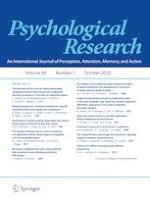29-04-2019 | Original Article
Yellow is for safety: perceptual and affective perspectives
Gepubliceerd in: Psychological Research | Uitgave 7/2020
Log in om toegang te krijgenAbstract
Is there a link between color and safety? Yellow is often used in safety contexts. Using the Singapore accident record datasets, Ho et al. provided evidence that yellow taxis have fewer accidents than blue taxis (Ho et al. in Proc Natl Acad Sci 114(12):3074–3078, 2017). Does yellow differentially influence attention and action and if so is this related to purely visual or affective factors? Here, we examined the visual priority of yellow relative to luminance matched colors at opposing ends of the wavelength spectrum (i.e., red and blue), using a temporal order judgment task, between color pairs. Despite being matched in arousal, when yellow and blue were pitted against each other, yellow was consistently seen as occurring first, even when objectively appearing second at short stimulus onset asynchronies. Despite being matched in valence, yellow again showed a larger temporal priority when it was pitted against red. Yellow temporal priority bias was modulated by individual differences in regulatory focus, highlighting a potential affective-motivational origin. These results support that yellow is a safety color, having a temporal advantage, and further evidence that colors have special influences on cognition, perception and behavior.
